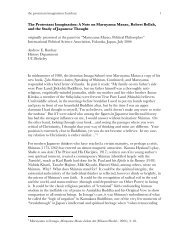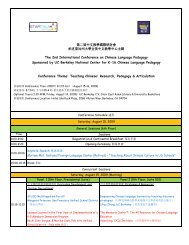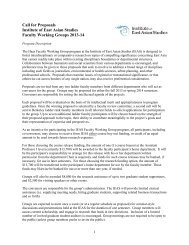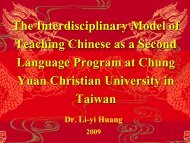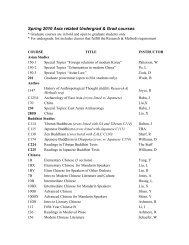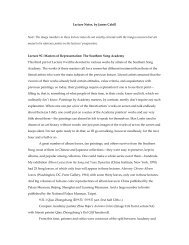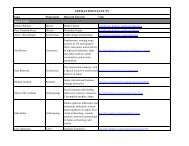Third Edition Spring 2013 - Institute of East Asian Studies, UC ...
Third Edition Spring 2013 - Institute of East Asian Studies, UC ...
Third Edition Spring 2013 - Institute of East Asian Studies, UC ...
Create successful ePaper yourself
Turn your PDF publications into a flip-book with our unique Google optimized e-Paper software.
THE RELEVANCE OF KAUTILYA’SARTHASHASTRARamanathan Veerappan55 Rachel PhoaAbstractThis paper demonstrates that Kautilya’s Arthashastra, the great ancientIndian political and economic treatise, is relevant today for its similarities toclassical economics, its practical applications to the modern corporate world,and the importance <strong>of</strong> Kautilya as a cultural icon. Before discussing Arthashastra’scontemporary relevance, some background information on the treatise—especially the issue <strong>of</strong> its authorship—will be provided. Focus will then shift tothe usefulness <strong>of</strong> Kautilya’s strategies for the modern corporation. The relevance<strong>of</strong> the Arthashastra to business and economics does not lie entirely in its applicationto the corporate world; Kautilya’s text is important for its striking similaritiesto later Western schools <strong>of</strong> thought. In this paper, the specific Westernschool <strong>of</strong> thought that will be examined is classical economics. Because Kautilyawas able to anticipate important political and economic ideas that individualsin the West would not conceive <strong>of</strong> until many centuries after his death, Kautilyahas become an iconic figure in India and his ideas have become a source <strong>of</strong> greatpride. This pride, when combined with the timely rediscovery <strong>of</strong> the Arthashastrain the early 1900s, allowed Kautilya to become a figure that nationalists usedto place Indian culture and thought on par with Western culture and thought.This paper will show that Kautilya and his famous treatise are relevant to themodern world for a variety <strong>of</strong> reasons and that Arthashastra deserves a placeamong the world’s greatest texts, ensuring that it will never again be lost to theworld.Kautilya, also known as Chanakya or Vishnu Gupta, was thechief advisor to the first Mauryan emperor—Chandragupta Maurya—andthe legendary author <strong>of</strong> one <strong>of</strong> India’s foremost politicaland economic texts, the Arthashastra. 2300 years ago his ideashelped build the Mauryan Empire, which at its height was one <strong>of</strong>the world’s largest empires and one <strong>of</strong> the most extensive empireson the Indian subcontinent. Kautilya’s theories were ahead <strong>of</strong> histime and could had been an important influence on later systems<strong>of</strong> thought, such as classical economics and Machiavellian politics,had Arthashastra not been lost from the end <strong>of</strong> the Gupta Dynasty(c. 500 CE) until the early 20th century. Kautilya’s work hasreemerged and scholars are examining its significance in light <strong>of</strong>modern politics, economics, and society. Although the Arthashastrais considered to be “an ancient system <strong>of</strong> thought designed forfeudal states which were <strong>of</strong>ten, if not constantly at war,” 1 “its preceptsabout social, political and economic structure are relevanteven today.” 2 India’s National Security Advisor Shiv Shankar Menonhas recently acknowledged the importance <strong>of</strong> Kautilya’s textstating “Arthashastra is a serious manual on statecraft, on how torun a state, informed by a higher purpose, clear and precise in itsprescriptions, the result <strong>of</strong> practical experience <strong>of</strong> running a state.It is not just a normative text but a realist description <strong>of</strong> the art <strong>of</strong>running a state.” 3 As men like Shiv Shankar Menon continue to discoverand embrace Kautilya’s Arthashastra as one <strong>of</strong> India’s mostimportant treatises, it has the potential to emerge on the forefront<strong>of</strong> modern economic thought for its striking similarities to classicaleconomics and its relevance to the corporate world. Similarly,Kautilya himself has the potential to enter the pantheon <strong>of</strong> India’sindigenous “politico-cultural” icons not only for the contribution <strong>of</strong>his ideas, but also for his role as a figure used by the Indian independencemovement to place Indian thought on par with Western1 Timothy Starzl, and Krishna Dhir, “Strategic Planning 2300 Years Ago: TheStrategy <strong>of</strong> Kautilya,” Management International Review, 26, no. 4 (1986), 75.2 Kautilya’s Arthashastra: Its Contemporary Relevance, (Pune: Indian Merchants’Chamber & Indian Merchants’ Chamber Economic Research and Training Foundation,2005), 143 “India needs to develop its own doctrine for strategic autonomy: NSA”Kautilya’s Arthashastra 56




